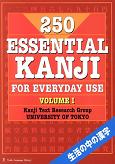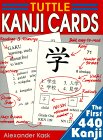
Essential Kanji: 2,000 Basic Japanese Characters Systematically Arranged for Learning and Reference
I must say that this is the best Kanji book I have seen. I still remember the wonder I felt when I first beheld this book on Christmas morning three years ago. It's very extensive, and has all of the Joyo Kanji which is more than 90% of the kanji you will ever encounter in an ordinary novel or newspaper, and probably more than 95% of the kanji you will see in any manga. The book is indexed by reading and stroke count and includes a radical chart with English meanings for all the radicals.
Each entry has the ON and kun readings with their corresponding meanings, the Chinese pronunciation, and a brief explanation of the character's derivation. For every kanji, there are two examples of the character in compounds using kanji already taught earlier in the book, a brush-stroke depiction of the character and a pen drawing, including pen drawings of any non-standard versions of the character. At less than $14, this book is a steal. I carried this book around everywhere for two years, and in that time, it became so battered from use that I have even bought a second copy.


Ntc's New Japanese-English Character Dictionary
At $34.96 (discounted price), it's a bit pricey, but it's less than I paid for it, and it's worth the price if you can afford it. This is probably the most extensive Kanji-English dictionary in print, with some 3500 kanji. And check out these features: The book is ordered using something called the SKIP system, which means that you can go directly to the kanji you're looking up, without an index. That's just one of the six lookup methods. It has three indexes: readings, stroke count and meaning (I've never seen this anywhere else).
Each entry has step-by step stroke diagrams, and examples of the character in Mincho (standard font), gyousho (semi-cursive), shousho (cursive), and the Chinese equivalent. Each entry also has numerous examples of the character in compounds demonstrating every meaning, cross references to related characters, usages of the character in names, almost every reading you will ever encounter, and the Chinese pronounciation in pinyin. There are also 834 cross reference entries for nonstandard versions of kanji and wrongly looked-up kanji.
I strongly recommend this for any hardcore Japanese learner. It's not really necessary for a beginner, and either way, you'll still need a smaller kanji book since you can't carry this one around wherever you go. For that, go for Essential Kanji (above). By the way, you can see 117 sample pages from this book if you look at its Amazon entry.


250 Essential Kanji for everyday use
Not to be confused with Essential Kanji by P.G. O'Neill. This book takes a nice interactive approach to learning kanji. It's arranged into 21 lessons, each with its own theme and about 11 kanji. Each lesson has an introduction, an introductory quiz to get you into the mindset of the Kanji you are about to learn, and a practice quiz at the end of each lesson. Each entry has a full stroke diagram, boxes for writing practice, an explanation of how the kanji arrived at its present shape (with illustrations), and about 6 usage examples. The book has 5 review exercises, useful appendices and indexes, and an introduction about the Japanese writing systems and the origins of kanji. Since the book is taught in themes, it includes a few mildly advanced kanji and leaves out some of the basic kanji, which may or may not be a good thing. Overall, it's a pretty good book, especially if your textbook doesn't teach kanji. It also does a good job of teaching basic aspects of getting around in Japan. There's also a Volume 2 of this book that has 22 new lessons and 250 more kanji.
From the makers of Tuttle Kanji Cards


I haven't used these cards but they are a big favorite among kanji learners everywhere. This review comes from JIP board member pblay.
Here's what you'll find on the cards:
- Front:
- A number for the card
- A large image of the kanji in neat brushstroke style
- The stroke count
- Four vocabulary words that use the kanji on the card and at least one other kanji
- The main radical and grade level
- Lookup number for various dictionaries (KKN + NNN)
- Reverse:
- The ID number again
- The ON reading(s) in capital letters and kun reading(s) in lowercase
- Okurigana (verb and adjective inflected parts) in parentheses [i.e.: no(ru/seru)]
- English meaning for each meaning separated by semicolon. Alternate English meanings for each reading are separated by commas
- Reading (in romaji) and English meaning for each vocabulary word
- Stroke guide for the kanji one stroke at a time
Comments:
There are some errors - I've personally noticed and corrected four or five mistakes. This, understandably, leaves me wondering what mistakes I've missed. These were all in the vocabulary words. I don't really have any other flash cards to compare to them except for hand made ones. The vocabulary words are a real bonus as you get to see some of the words in common use that use the kanji. It also gives you an idea of the euphonic changes (i.e.: t->d, s->z, tsu->t,p, etc.) you have to expect in Japanese.
The cards are flipped vertically to reveal the 'answers'. Presumably to stop you reading them through the card when the light is behind you, although the card is reasonably thick. Minor annoyance - it's not very easy to put the cards back into their box. They fit (just) in four piles and internal dividers would have been useful.
How easy are they to learn from?
Well they are more portable and intuitive to use than a computer program equivalent (Japan Flash Card, etc.) I would say they work well for recognition / reading / vocabulary cramming if you put the hours in. By my current estimate I'll have seen the last 'new' card in about two days time - then I get to do them all over again. However, they certainly don't substitute for a decent kanji dictionary. I recommend "The Kodansha Kanji Learner's Dictionary" Jack Halpern, ISBN 4-7700-2335-9. If you are just starting kanji then you would probably be better off with a text book that introduces kanji gradually, in context.
Value for money? Considering the amount of time you could spend using them they are a real bargain.


Remembering the Hiragana/Katakana: A Complete Course on How to Teach Yourself
This book used two be two separate books, one for hiragana and one for katakana. I personally used the book for katakana, because by the time I discovered these books, I already knew hiragana. James Heisig takes a really interesting approach to teaching the kana. He divides them into lessons by common themes and doesn't teach them in order. He gives a sort of mnemonic device for learning each one, so that readers learn the kana by associative memory, not by rote memory.
Each page has one kana, and shows it in the corner of the page, in four different styles in the middle of the page, and shows how it was originall derived from a kanji. It also shows a step-by-step stroke order and has cumulative examples of the character used in words (using other characters already taught in the lessons.) I think it's a really useful book, and fairly inexpensive. If you dedicate some time to it, you should be able to learn all of the kana in a matter of days. To facilitate this, the author provides some memorization games that I have found very useful, not just for learning the katakana, but for learning Kanji and vocabulary words as well.


Here's a book that contains about 200 Japanese idioms, each of which is composed of four kanji. For every idiom, there is a literal translation of the kanji, a series of idiomatic meanings, and two or three example sentences using the idiom. This book is good as a vocabulary builder, and Japanese people will be impressed if they hear you using these expressions. Nevertheless, it's not worth trying this book until you have a few hundred kanji under your belt. At that point, this book will serve as good practice for the kanji readings and for other vocabulary and grammar contained in the example sentences. As with almost all Power Japanese books, every example sentence is printed in Japanese characters, romaji and a full English translation. Recommended for intermediate learners.